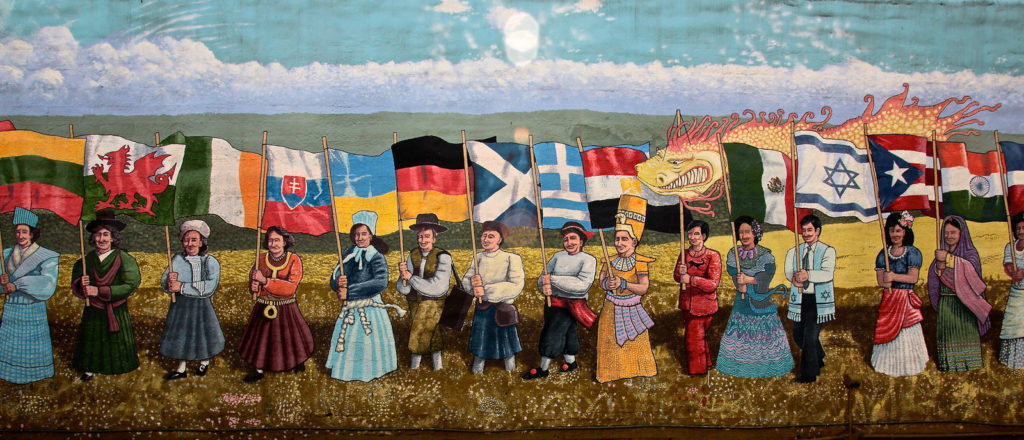As the US grows more diverse, so too do its urban neighborhoods. A new paper—“ Global Neighborhoods: Beyond the Multiethnic Metropolis”–published in Demography by Wenquan Zhang and John Logan traces out the changes in the racial and ethnic composition of US neighborhoods over the past three decades. Their chief finding: more and more American’s live in multi-ethnic “global neighborhoods”—places that have a significant representation of whites, African-Americans, Latinos and Asians. Between 1980 and 2010, the number of global neighborhoods in the US tripled, while the number of predominantly white neighborhoods fell by half.
Count of Census Tracts, by Neighborhood Category, 1980 and 2010
| Neighborhood Category | 1980 | 2010 | Pct. Change |
| All White | 16,254 | 8,145 | -50% |
| All Minority | 3,762 | 6,408 | 70% |
| Semi-Global | 4,495 | 9,346 | 108% |
| Global | 3,858 | 10,378 | 169% |
Source: Zhang & Logan, Tables 3-6.
What exactly is a “global neighborhood”?
Zhang and Logan define a global neighborhood as one that has the presence of all of four major ethnic groups (white, black, Hispanic and Asian). Presence is defined as having an ethnic group represented at a level equal to at least one-quarter of the level found in metropolitan areas a whole in the United States. In 2010, metro areas were 42 percent white, so the threshold for white presence was 10.5 percent. Similarly, the thresholds in 2010 were 4.5 percent for black presence, 7.4 percent for Hispanic presence and 2.4 percent for Asian presence. The study includes data for 342 metropolitan areas, all with populations of at least 50,000 persons.
Despite fears that gentrification causes formerly minority-dominated neighborhoods to become “all white,” Zhang and Long’s data show that this almost never happens. Of 3,762 all-minority neighborhoods in 1980 (i.e. census tracts where whites made up fewer than 15.8 percent of the population), only 2 tracts changed to all white in the succeeding 30 years (i.e. a tract where fewer than 7.4 percent were Hispanic, fewer than 4.5 percent were black and fewer than 2.4 percent were Asian.
Some of the growing neighborhood level diversity of US cities and suburbs is baked in the demographic cake. Because the share of the nation’s population that is white, non-Hispanic is decreasing and the share that is Asian, African-American or Latino is increasing, the typical American neighborhood is automatically becoming more diverse. One of the significant findings of Zhang and Logan’s work is that neighborhoods are becoming diverse even faster than is explained by the demographic shift alone.
Invasion-succession versus buffers
One dominant thesis of racial neighborhood change has been the so-called “invasion-succession” model. Neighborhood change happens when a neighborhood dominated by one group (usually whites) is “invaded” by a different group, (usually blacks), and because of white flight, the neighborhood changes from predominantly white to predominantly black. This model of implies that neighborhood change happens, but that integration is an unstable and temporary state, and that ultimately, segregation gets recapitulated with new geographic boundaries.
While the “invasion-succession” model may have done a reasonably good job of explaining neighborhood change in the 1950s, 60s and 70s, it now appears to be far less common. Earlier at City Observatory we reviewed a study looking at neighborhood change which found that once integrated, neighborhoods tend to stay that way.
Zhang and Logan confirm this general trend, and what’s more, offer an interesting insight into how racial buffering is easing the transition to more diverse neighborhoods. They point out that predominantly white neighborhoods with relatively high shares of Latinos and Asians both stay diverse, but then also attract more black residents over time. As they explain
Hispanics and Asians provide an effective social cushion and/or spatial separation between blacks and whites in integrated communities. The buffer in some way absorbs tensions and fosters acceptance between groups, making it possible for blacks and whites to share a neighborhood despite racial barriers in the society at large.
One trend continues to reinforce traditional patterns of segregation: the very low probabilities that majority minority neighborhoods transition to becoming more integrated. Of the predominantly non-white neighborhoods in 1980, more than 80 percent were still non-white neighborhoods in 2010.

